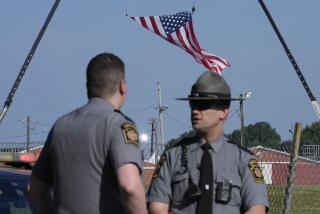Did North Charleston, S.C., police try to aid Walter Scott after shooting?
- Share via
Reporting from NORTH CHARLESTON, S.C. — The graphic and now familiar video showing Officer Michael T. Slager shooting Walter L. Scott does not include images of officers aiding Scott, leading some people to question whether police tried to save the man’s life.
But according to accounts by officers, there was a flurry of activity to help the mortally wounded man.
There were at least seven officers on the scene, according to the incident report. In the three-minute video made public Tuesday, officers walk around the scene, pull up Scott’s shirt and briefly check his pulse.
Slager’s actions and the seeming lack of effort to give medical care have angered people within the community.
“He was more interested in covering up than trying to save the life of this man he had just shot in the back,” North Charleston NAACP President Edward Bryant III said of Slager. “He was trained. He was locked in on what to do — and that was to cover up what he had done.”
The local National Assn. for the Advancement of Colored People leader accused Slager, who has been fired and charged with murder, of planting his Taser stun gun next to Scott’s body to buttress his account of the shooting. The officer told a dispatcher, referring to Scott, “He took my Taser,” according to the North Charleston Police Department incident report.
Accounts from other officers describe efforts to save Scott.
An officer who arrived moments after the shooting was “administering first aid,” according to the police report. A third officer, it says, arrived and assisted in providing medical care.
“I exited my vehicle and assisted Officer Habersham with first aid and CPR to the driver,” Sgt. J. Gann said in the report. “We continued to perform first aid and CPR until EMS arrived on scene.”
The account from Habersham, whose full name was not given, does not mention CPR, however.
“I attempted to render aid to the victim by applying pressure to the gunshot wounds,” Habersham said.
An account of the shooting provided by an officer identified as Sgt. Webb mentioned only that Habersham administered chest compressions, and another description said multiple officers tried to help Scott.
North Charleston police did not return requests for comment. Charleston County Emergency Medical Services said it received a call at 9:40 a.m. and arrived on the scene five minutes later. Scott was “DOA shortly after their arrival,” said Don Lundy, chief of EMS.
During a news conference Wednesday, Police Chief Eddie Driggers struggled to answer questions about officers’ first aid response.
“Was CPR ever performed on this man, as far as you know?” a reporter asked.
“I’m going to be totally honest with you —” Driggers replied before a man in the audience cut him off.
“Do that,” the man said.
“I am. And give me just a second. The honesty comes from my heart. I have watched the video, and I was sickened by what I saw,” Driggers said. “What I saw was … I believe to be a police officer removing the shirt of the individual and performing some type of lifesaving. But I’m not sure what took place there.”
“But you don’t know if CPR was performed?” the reporter asked again.
“I do not know. I was told that lifesaving — that they tried to save his life,” Diggers said.
South Carolina Criminal Justice Academy does not provide first aid training during the 12-week program, the academy said, but Slager’s personnel file shows he was trained in first aid and CPR.
The Rev. Thomas Dixon, an African American community organizer in North Charleston, says many black residents are so conditioned to expect mistreatment that some black leaders were not surprised when Slager did not appear to offer Scott assistance after shooting him.
“In our community, we expect that kind of behavior,” Dixon said.
Twitter: @parviniparlance
Twitter: @davidzucchino
More to Read
Sign up for Essential California
The most important California stories and recommendations in your inbox every morning.
You may occasionally receive promotional content from the Los Angeles Times.















